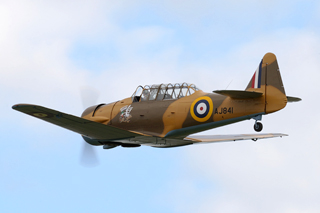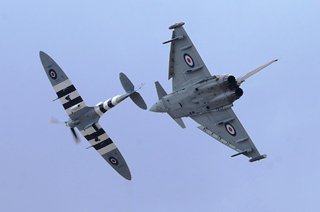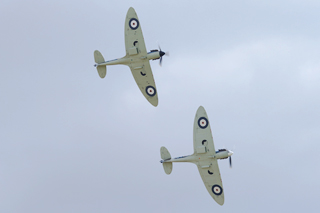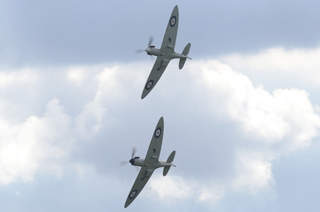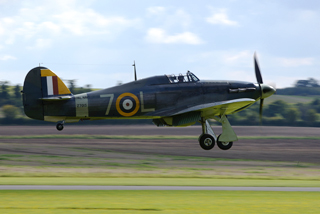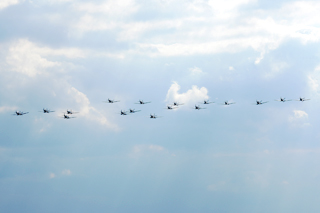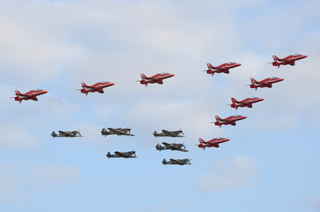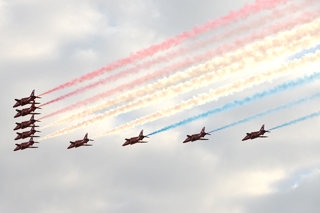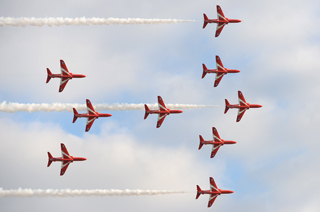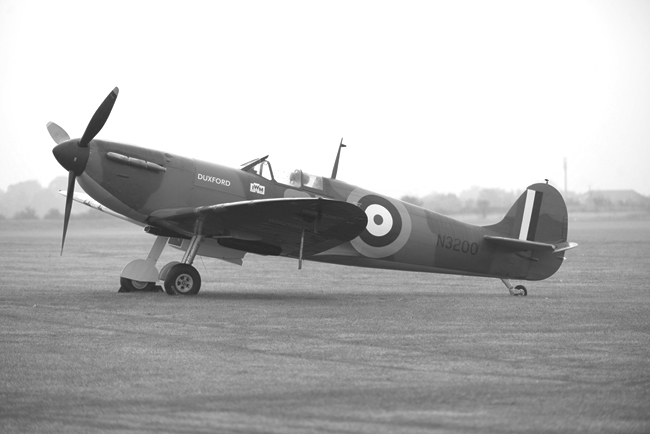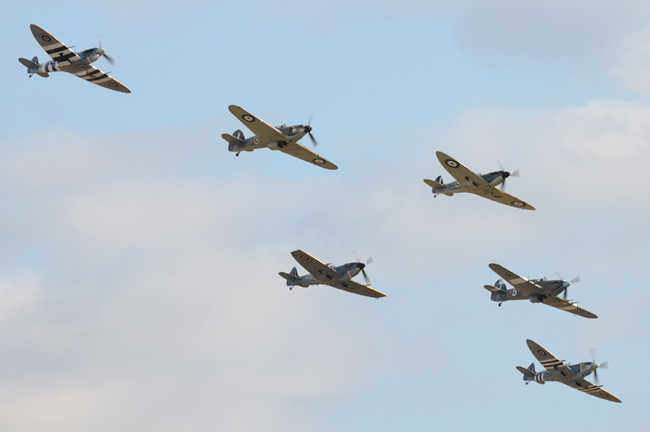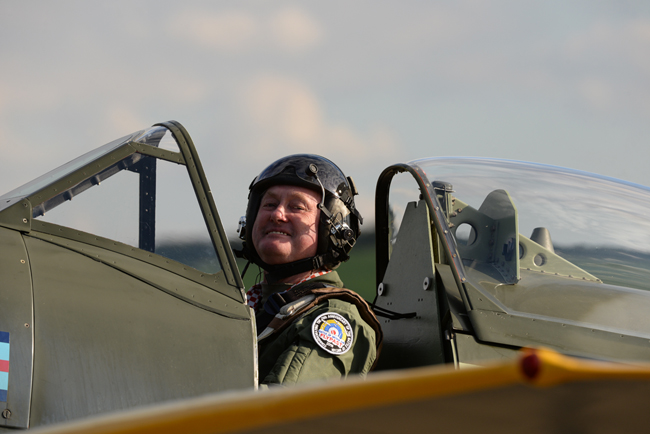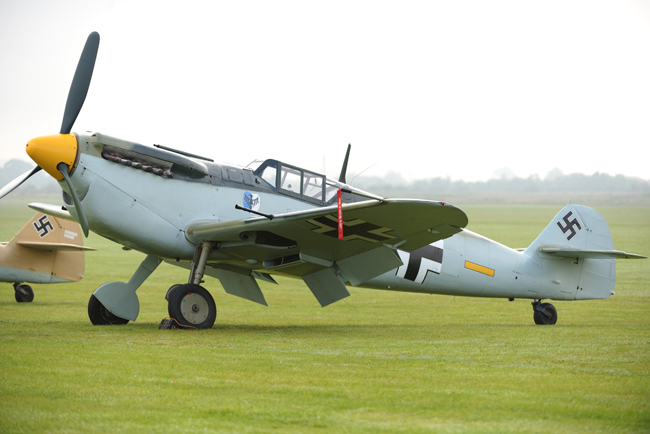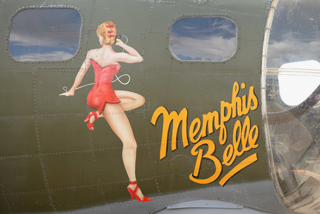This
eFLYER was developed in HTML for viewing with Microsoft Internet Explorer
while connected to the Internet: View
Online.
To ensure delivery to your inbox, please add eFLYER@barnstormers.com to
your address book or list of approved senders.
|
 |
ISSUE 433 - June 2016
Over 9,000 Total Ads Listed
1,000+ NEW Ads Per Week |
| Duxford Battle of Britain Airshow 2015 - Part III |
By Kevin Moore, Contributing
Editor & Photographer
Watford, Ontario, Canada |
|
|
This week we return to Duxford and check out the remaining aircraft that flew
during the show, including the many Spitfires that attended. |
| Last week we returned to the Duxford Battle of Britain 2015 Airshow to have a look at several more performers. Once again, we return to Duxford for a final look at the last of the aircraft that took part, including Harvards, Spitfires, Hurricanes and the famous RAF Red Arrows. |
|
|
The venerable Harvard was an important training aircraft,
flying with many different Allied/Commonwealth air forces. |
| Three Harvards took part in the airshow performing several passes. Originally built as a T-6 Texan in the United States, it was built by North American Aviation and first flew in 1935. The Harvard, as it was known in most Commonwealth countries, was built under license in Canada by Noorduyn Aviation, building the Harvard IIB of which 2485 aircraft were produced. Arguably, the best version of the aircraft was built in Canada by Canada Car & Foundry in the 1950s known as the Harvard 4. More than 15,000 variants of the Harvard/T-6/SNJ were built and many aircraft still fly today. The Harvard has a cruise speed of 145mph with a maximum speed of 208mph and a service ceiling of more than 24,000'. |
|
|
| The American built Curtis H75-C1 Hawk, canopy cover on, awaits a busy day of flying, left. The Curtis Hawk in formation with the Gloster Gladiator, right. |
| An unusual aircraft at the Duxford Airshow was the French Air force, American built, Curtis H75-C1 Hawk, which first flew in May of 1935. Probably best known as the predecessor of the Curtis P-40 Warhawk, but powered by a radial engine, the Hawk saw very little combat action other than by the French Armee de l'air during the Battle of France. Curtis Hawks served with militaries of France, China, India and Britain and, after the fall of France, Hawk's seized by the Germans were transferred to Finland seeing action against the Soviets. The Hawk had a maximum speed of 313mph, a cruise speed of 270mph and a service ceiling of more than 32,000'. The last Hawks were withdrawn from service in Argentina in 1954. |
|
|
The Yak 52s of the Aerostars display team. |
| The Yak 52 Aerostars display saw the pilots putting their aircraft through a series of graceful manoeuvres. The Yak 52 is a two seat, aerobatic Russian built aircraft which first flew in 1976. It was designed to be an aerobatic training aircraft for both military and civilian use and is still being produced today but Romanian Company, Aerostar. The Aerostars precision aerobatic team flies an assortment of formation aerobatics including opposing passes, breakaways and inverted manoeuvres. Their Yak 52 TW aircraft are powered by a 400hp, nine-cylinder, supercharged radial engine offering speeds in excess of 225mph. Yak 52s were utilised by at least 13 militaries, mostly eastern bloc countries, with many aircraft having fallen into private hands around the world who still fly them today. |
|
|
The RAF Eurofighter Typhoon and RAF BBMF Spitfire in formation as the Battle of Britain Heritage Flight during the 2015 airshow season. |
| The Heritage flight at Duxford included the RAF Eurofighter Typhoon flying formation with a BBMF Supermarine Spitfire Mk Vb. The Typhoon is painted in remembrance of the 75th anniversary of the Battle of Britain, wearing the markings of 249 Squadron pilot Flight Lieutenant James Brindley Nicolson, VC, DFC. F/L Nicolson was the only Fighter Command pilot awarded the Victoria Cross during the Battle of Britain. Unfortunately, due to new regulations introduced to the airshow industry in the UK after the tragic Hawker Hunter crash at Shoreham in August of 2015, the formation was restricted to completing their formation passes within the airshow box as a result of a line up of traffic along the nearby motorway which meant no topside passes of the duo. Regardless, the beautiful and unique lines of both aircraft were evident and enjoyable to watch. |
|
|
The sight and sound of the Comanche owned Spitfires performing
a graceful display in the skies above Duxford. |
| Probably the most graceful and beautiful of the displays was that of the Comanche Fighters Spitfire duo, flying beautiful Mk I Spits. All heads were turned skyward watching these two iconic and stunningly beautiful aeroplanes flying their ballet above the skies of Duxford. The sight and sound sent chills up the spine and was a wonderful lead up to the later mass formation of Spitfires that was to come. Designed by engineer, R. J. Mitchell, he originally wanted the name "Shrew" for his, soon to be, famous fighter and thought the name Spitfire to be "damned silly." Despite that, and in retrospect, there likely isn't a better name than that which it has been known by. There were many marks and variants of the Spitfire during 10 years of production and more than 20,000 of the famous fighter aircraft were built including both the Spitfire and it's naval sister, the Seafire. |
|
|
| The Hawker Hurricane, left, flew in greater numbers against the German Luftwaffe during the Battle of Britain. A Sea Hurricane, right. landing after performing in the show. |
| Though the Spitfire has become the aircraft most synonymous with the historic Battle of Britain, the Hawker Hurricane flew in greater numbers and actually shot down more aircraft than did the Spitfire during that timeframe. That's not to belittle the name of the Spitfire, but both aircraft should probably be equally credited for preventing the Germans from obtaining air superiority during the famous battle. The Hurricane, however, was often pushed to attack the bombers while the Spitfires went up against escorting fighter aircraft. Some argue that the reasons were that there were fewer Spitfires and that they were too valuable to put up against the German bombers because Hurricanes were more readily available and easier and cheaper to repair. Whatever the reason, the Hurricane was loved by her pilots and performed fabulously in her Battle of Britain role. Eventually, she was relegated to other tasks where she was equally as effective. The Hurricane first flew in November of 1935 and more than 14,500 were built in the UK and Canada until the end of 1944. Several Hurricanes performed in flypasts during the Duxford Airshow, including two from the famous RAF Battle of Britain Memorial Flight. |
|
|
| The "Big Wing" formation of 17 Spitfires was impressive in both sight and sound. |
| There were at least 21 Spitfires that attended the Battle of Britain Airshow at Duxford, though only 17 participated in the show itself. There were Spitfires from around Britain that came to Duxford to be part of the historic flypast including Mk I, Mk V, Mk IX, Mk XIV, MK XVI and others, both Merlin and Griffon powered variants. The sight and sound was one that Spitfire purists, lovers and weekend airshow geeks absolutely had to stop and watch and listen to. The sound of those 17 fabulous Rolls-Royce engines had the crowd silenced, hearts pounding and, in some cases, tears flowing. Admittedly, even the photographer/author simply stopped shooting to watch and listen! |
|
|
| It doesn't matter whether you're seeing a formation of 17 Spitfires, or 5 Spitfires, one is as impressive and as enjoyable to the eye as is the other. |
| Of the 17 Spitfires that flew during the mass flypast, there was a mix of single and two-seat Spitfires as well as Seafires. As different as the marks of Spitfire there were on hand, the liveries were also as different and included Spitfires in RAF, RCAF, RAAF and Royal Navy markings. They took off in single and multiple formations, taking time to amass a few miles from Duxford into their "big wing" before returning to the aerodrome for their mass flypast. After completing several passes together, they separated and began performing multiple formation passes in twos and threes before again separating into single aircraft performing multiple individual passes. Spitfire after spitfire, in two lines across the airfield, flew beautiful, high speed passes, overwhelming photographers throughout the flightline as it was impossible to keep up. There's been nothing more glorious or fantastic to witness in these many years! |
|
|
The RAF Red Arrows aerobatic display team and the
RAF BBMF formation of 4 Spits and 2 Hurris. |
| Rounding out the Sunday airshow was another historic flypast which included a mix of Rolls-Royce powered aircraft and Armstrong Siddeley/Rolls-Royce turbojet engine aircraft in a formation including the BBMF Spitfires & Hurricanes and 9 RAF Red Arrows BAe Hawk. This fabulous formation was in honour of those who flew during the Battle of Britain. Though these aircraft are very different in design, power and speed, their designs were only 15 or so years apart. The formation consisted of 4 Spitfires, 2 Hurricanes and the 9 Red Arrows Hawks. |
|
|
| The BBMF, Battle of Britain Memorial Flight, consists of several assorted former RAF aircraft including this formation of 6 aircraft; 4 Spitfires and 2 Hurricanes. |
| The BBMF operates 12 assorted aircraft including the 6 Spitfires and 2 Hurricanes that appeared at the Duxford Airshow. They also operate one of only 2 flying, airworthy Lancaster bombers, 2 Dakotas and a de Havilland Chipmunk. The BBMF's Spits and Hurris performed several formation passes before joining the RAF Red Arrows in their historic flypast as seen previously. The Spitfires consist of a Mk Vb, Mk LFIXe, Mk IIa, two Mk PRXIX and a Mk LFXVIE. The Hurricanes consist of two Mk IIc's, one of which was the last Hurricane ever built. |
|
|
The fabulous RAF 9-plane formation of BAe Hawk aircraft
that make up the Red Arrows display team. |
| The RAF Red Arrows are among the elite of the premier military aerobatic teams in the world. First formed in 1964 by amalgamating the RAF Black Arrows and the Red Pelicans into the Yellowjackets flying as a 7-plane team until 1968 when the team was permanently increased to 9 aircraft and renamed the Red Arrows flying the Folland Gnat. In 1980, the RAF replaced the Gnat with the BAe Hawk and then, in 1983, the team moved from RAF Kemble to RAF Scampton, its permanent home. Over the 50+ year history of the team, the Red Arrows have flown well over 4,700 displays in 56 countries around the world. The teams trademark formation is that of the Diamond nine, though the 2016 season will see a slightly different form of their famous formation. If you're an aerobatic display team fan, especially that of the jet teams, then you don't want to miss an opportunity to see this fabulous team at work, displaying throughout the UK. |
|
|
| The RAF Red Arrows showing bottom side, left. One of the many Spitfires on final, right. |
| RAF Duxford, and their three airshows every season, is a great place to see British aviation history come alive. Whether you're a fan of the Spitfire, Hurricane, Mustang, B-17 or the many assorted aircraft at Duxford, and the visiting aircraft, you will enjoy a visit for an airshow or to the two museums on location, the Imperial War Museum and the American Air Museum. Ideally, you'll need a day for each museum, let alone a day for any airshow you happen to take in while there. Plan on staying somewhere locally and spending at least 2 days at Duxford. It's worth the visit regardless of whether you're from the UK, or touring from another country, add Duxford to your schedule. You won't be disappointed! |
|
Sitting on the grass awaiting her pilot, the iconic Spitfire
as she may have looked during the Battle of Britain in 1940. |
|
| The 4 Spitfires and 2 Hurricanes of the BBMF in formation. |
|
| The 17-plane formation of Spitfires approaching for another pass. |
|
| How could you not have a big grin after flying the iconic Spitfire!? |
|
| One of two Me109's that took part in the airshow. |
|
| The lovely lines of the Hawker Hurricane are evident when caught at this angle. |
|
| The Slingsby T.6 Kirby Kite sitting along the flightline on a cool, misty morning. |
|
|
The B-17 wears two faces, as it were, the "Sally B" on the port side, left,
and the "Memphis Belle" on the starboard side, right. |
|
The Hurricane was built in both the UK and in Canada and served with several
different Commonwealth air forces, as well as the Russian Air Force. |
|
| The Gloster Gladiator was one of the last biplanes to serve with the RAF. |
|
| |
|






